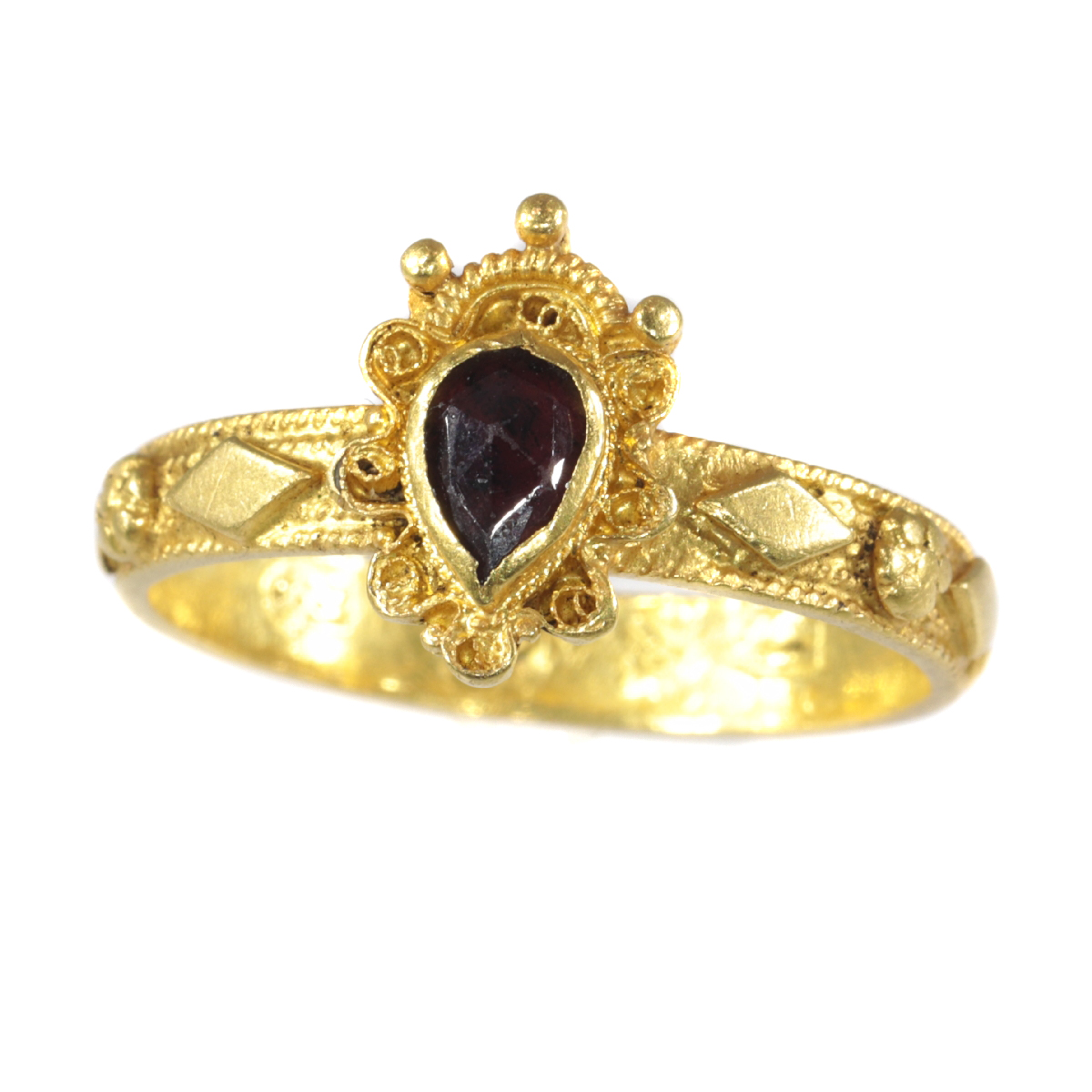We offer layaway, spread payments on the piece of your dreams. Ask us for details. Free insured shipping on all orders !!!
Late Baroque gold garnet ring hallmarked Amsterdam 1692
We are thrilled to share the marvel of this authentic antique yellow gold ring of high carat gold,
as it's the most literal timestamp possible for the year 1692.
With many decades of dealing in antique jewellery on a daily basis, we can consider that it's extremely rare to come
across jewellery of such an old age and -on top of that- with hallmarks.
How remarkable it is that the ring clearly bears the hallmarks for Amsterdam and the year letter F for the year 1692.
To come along Dutch 17th Century jewellery that is so clearly hallmarked is extremely rare!
As an extra mark of the baroque period in which this unique ring came to be,
its excentic design consists of a drop shaped rose cut garnet top with a filigree aura and a ring shank covered
with gold lozenges alternating with gold flower granules.
Once, this ring may have been crafted as part of a person's history, but now each person it touches actually
becomes part of the ring's own chronicle. What an extraordinary experience to be part of something before and
beyond yourself.
Antique jewelry object group: ring
Condition: very good condition
- (more info on our condition scale)
Country of origin:
Amsterdam, Netherlands
Style:
Baroque - Baroque is an artistic style prevalent from the late 16th century to the early 18th century in Europe. It is most often defined as "the dominant style of art in Europe between the Mannerist and Rococo eras, a style characterized by dynamic
movement, overt emotion and self-confident rhetoric".
- See also: Baroque
or more info on styles
Style specifics:
Baroque is a style in art and decoration that developed shortly before 1600 and remained current in Europe until the emergence of the Rococo style c.1730. It was started in Italy, and spread to Germany, Austria, the Low Countries, and Spain and
Portugal, with only a somewhat severely classical version being popular in France under Louis XIV. The style was a development of the Renaissance style and is characterized by lively, curved, and exuberant forms, by vigorous movement, and by rich
ornament, based on classical sources, being symmetrical as distinguished from the asymmetry of the following Rococo style.
Period: exactly 1692 !
- (events & facts of this era, poetry of this era,
fashion of this era)
Material: high carat (18K+) yellow gold
- (more info on precious metals)
Technique:
Granulation is a technique where the goldsmith uses very small balls (granules) of metal, which are not soldered to the piece but welded. This technique demand very high skills and precision from the maker. And filigree (formerly written filigrann or
filigrane) which is a delicate kind of jewel work made with twisted threads usually of gold and silver or stitching of the same curving motifs. It often suggests lace and French from 1660 to the late 19th century. It should not be confused with ajoure
jewellery work; while both have many open areas, filigree involves threads being soldered together to form an object and ajoure involves holes being punched, drilled, or cut through an existing piece of metal. (from: Wikipedia)
Extra information: Although antique jewellery is our business, it rarely happens that we run into
a piece of jewellery that is so well hallmarked as this one. And not only does it bare clearly recognisable hallmarks
it's also of an age and high quality that we hardly ever have!
Precious stones:
One
garnet
Birthstones:
Garnet is the birthstone (or month stone) for January.
- (more info on birthstones)
More background information on the hallmarks: These hallmarks can be found in
"Merken van Amsterdamse Goud- en Zilversmeden" (hallmarks of Amsterdam gold- and silver smiths)
By Elias Voet JR 1912.
See our pictures for the various books we have on this subject.
Hallmarks: Clearly recognisable hallmarks for Amsterdam and the year letter F for the year 1692.
The mastermark is not clear enough to find out who the maker was of this ring.
See also the picture we took of the hallmarks at the inside of the shank.
- (more info on hallmarks)
Dimensions: width of top of ring 1,10 cm (0,43 inch)
- See picture with a ruler in cm and inches
Weight: 3,40 gram (2,19 dwt)
Ring size Continental: 53 & 17 , Size US 6¼ , Size UK: M
Resizing:
Resizing is possible but because of the age of the ring we prefer to leave it untouched. We could make an additional inner ring so the ring itself is not harmed, for this work we have to charge. We cannot guarantee to make it on every size; so please
ask in advance. Return policy on this ring is not valid anymore once this work has been done.
- (more info on ring sizes)
Adin Reference Nº: 19351-0071
Copyright photography: Adin, fine antique jewellery
yellow gold jewelry,
jewelry with garnet,
latest acquisitions,
antique jewelry,
estate jewelry,
vintage jewelry or
modern jewelry
Jewelry with birthstones (or month stones) for:
January -
February -
March -
April -
May -
June -
July
August -
September -
October -
November or
December.
Additional information:
jewelry glossary -
wall of fame -
visit us in Antwerp -
subscribe to our mailinglist.
What is antique jewelry? -
What is estate jewelry? -
What is vintage jewelry?




